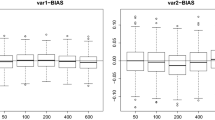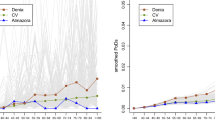Abstract
Analysis of area mortality variations and estimation of area life tables raise methodological questions relevant to assessing spatial clustering, and socioeconomic inequalities in mortality. Existing small area analyses of US life expectancy variation generally adopt ad hoc amalgamations of counties to alleviate potential instability of mortality rates involved in deriving life tables, and use conventional life table analysis which takes no account of correlated mortality for adjacent areas or ages. The alternative strategy here uses structured random effects methods that recognize correlations between adjacent ages and areas, and allows retention of the original county boundaries. This strategy generalizes to include effects of area category (e.g. poverty status, ethnic mix), allowing estimation of life tables according to area category, and providing additional stabilization of estimated life table functions. This approach is used here to estimate stabilized mortality rates, derive life expectancies in US counties, and assess trends in clustering and in inequality according to county poverty category.



Similar content being viewed by others
References
Bell F, Miller M (2005) Life tables for the United States social security area 1900–2100, actuarial study no. 120, US Social Security Administration, Washington
Besag J, York J, Mollié A (1991) Bayesian image restoration with, two applications in spatial statistics. Ann Inst Stat Math 43(1):1–59
Brooks S, Gelman A (1998) General methods for monitoring convergence of iterative simulations. J Comput Graph Stat 7(7):434–45
Chambers R, Tzavidis N, Salvati N (2009) Borrowing strength over space in small area estimation: comparing parametric, semi-parametric and non-parametric random effects and M-quantile small area models. Centre for Statistical and Survey Methodology, University of Wollongong, Working Paper 12–09. Retrieved November 10 2012 from http://ro.uow.edu.au/cssmwp/32
Congressional Budget Office (2008) Growing Disparities in Life Expectancy. US Congress, Wahington. Retrieved November 1 2012 from http://www.cbo.gov/publication/41681
Cooper R, Kennelly J, Durazo-Arvizu R, Oh H, Kaplan G, Lynch J (2001) Relationship between premature mortality and socioeconomic factors in black and white populations of US metropolitan areas. Public Health Rep 116(5):464–73
Cossman J, James W, Cosby A, Cossman R (2010) Underlying causes of the emerging nonmetropolitan mortality penalty. Am J Public Health 100(8):1417–1419
Durbin J, Koopman S (2001) Time series analysis by state space methods. Oxford University Press, Oxford
Eayres D, Williams E (2004) Evaluation of methodologies for small area life expectancy estimation. J Epidemiol Commun Health 58(3):243–9
Ezzati M, Friedman A, Kulkarni S, Murray C (2008) The reversal of fortunes: trends in county mortality and cross-county mortality disparities in the United States. PLoS Med 5(4):e66. doi:10.1371/journal.pmed.0050066
Farmer, F, Stokes, C, Fiser R, Papini D (1991) Poverty, primary care and age-specific mortality. J Rural Health 7(2):153–169
Galea S, Tracy M, Hoggatt K, Dimaggio C, Karpati A (2011) Estimated deaths attributable to social factors in the United States. Am J Public Health 101(8):1456–65
Harper S, Lynch J, Burris S, Davey-Smith G (2007) Trends in the black-white life expectancy gap in the United States, 1983–2003. JAMA 297(11):1224–1232
Kakwani N, Wagstaff A, van Doorslaer E (1997) Socioeconomic inequalities in health: measurement, computation and statistical inference. J Econom 77(1):87–103
Karpati A, Galea S, Awerbuch T, Levins R (2002) Variability and vulnerability at the ecological level: implications for understanding the social determinants of health. Am J Public Health 92(11):1768–72
Kawachi I, Kennedy B, Lochner K, Prothrow-Stith D (1997) Social capital, income inequality, and mortality. Am J Public Health 87(9):1491–1498
Kulkarni S, Levin-Rector A, Ezzati M, Murray C (2011) Falling behind: life expectancy in US counties from 2000 to 2007 in an international context. Popul Health Metr 9(1):16. doi:10.1186/1478-7954-9-16
Low A, Low A (2004) Measuring the gap: quantifying and comparing local health inequalities. J Publ Health Med 26(4):388–396
Lunn D, Spiegelhalter D, Thomas A, Best N (2009) The BUGS project: evolution, critique and future directions. Stat Med 28(25):3049–3067
McLaughlin D, Stokes S, Nonoyama A (2001) Residence and income inequality: effects on mortality among US counties. Rural Sociol 66(4):579–598
McLaughlin D, Shannon Stokes C, Johnelle Smith P, Nonoyama A (2007) Differential mortality across the US: the influence of place-based inequality. In: Lobao L, Hooks G, Tickamyer A (eds.) The sociology of spatial inequality. SUNY Press, Albany, NY, pp 141–162
Mansfield C, Wilson J, Kobrinski E, Mitchell J (1999) Premature mortality in the United States: the role of geographic area, socioeconomic status, household type, and availability of medical care. Am J Public Health 89(6):893–898
Mardia K (1988) Multi-dimensional multivariate Gaussian Markov random fields with application to image processing. J Multivar Anal 24(2):265–284
Mitra S (1973) On the efficiency of the estimates of life table functions. Demography 10(3):421–426
Murray C, Kulkarni S, Michaud C, Tomijima N, Bulzacchelli M (2006) Eight Americas: investigating mortality disparities across races, counties, and race-counties in the United States. PLoS Med 3:e260. doi:10.1371/journal.pmed.0030260
NCHS (2001) Health, United States, 2001, with urban and rural health chartbook. National Center for Health Statistics, Hyattsville, Maryland
Palloni A, Arias E (2004) Paradox lost: explaining the Hispanic adult mortality advantage. Demography 41(3):385–415
Probst J, Moore C, Glover S, Samuels M (2004) Person and place: the compounding effects of race/ethnicity and rurality on health. Am J Public Health 94(10):1695–1703
Richardson S, Monfort C (2000) Ecological correlation studies. In: Elliott P, Wakefield J, Best N, Briggs D (eds) Spatial epidemiology methods and applications. Oxford University Press, Oxford, pp 205–220
Riggan W, Manton K, Creason J, Woodbury M, Stallard E (1991) Assessment of spatial variation of risks in small populations. Environ Health Perspect 96(Dec):223–238
Shrestha L (2006) Life expectancy in the United States. Congressional research service, US Congress, Washington
Singh G (2003) Area deprivation and widening inequalities in US mortality, 1969–1998. Am J Public Health 93(7):1137–1143
Singh G, Siahpush M (2006) Widening socioeconomic inequalities in US life expectancy, 1980–2000. Int J Epidemiol 35(4):969–79
Spiegelhalter, D, Best, N, Carlin, B, van der Linde, A (2002) Bayesian measures of model complexity and fit. J R Stat Soc B 64(4):583–639
Toson B, Baker A (2003) Life expectancy at birth: methodological options for small populations. National Statistics Methodological Series no. 33. Office of National Statistics, London
Wagstaff A, Paci P, van Doorslaer E (1991) On the measurement of inequalities in health. Soc Sci Med 33(5):545–557
Weinick R, Zuvekas S, Cohen J (2000) Racial and ethnic differences in access to and use of health care services, 1977 to 1996. Med Care Res Rev 57 (Suppl 1):36–54
Yao L, Robert S (2011) Examining the racial crossover in mortality between African American and white older adults: a multilevel survival analysis of race, individual socioeconomic status, and neighborhood socioeconomic context. J Aging Res 2011:132073. doi:10.4061/2011/132073
Zhu L, Gorman D, Horel S (2006) Hierarchical Bayesian spatial models for alcohol availability, drug “hot spots” and violent crime. Int J Health Geograph 5:54. doi:10.1186/1476-072X-5-54
Author information
Authors and Affiliations
Corresponding author
Rights and permissions
About this article
Cite this article
Congdon, P. Estimating life expectancies for US small areas: a regression framework. J Geogr Syst 16, 1–18 (2014). https://doi.org/10.1007/s10109-013-0177-4
Received:
Accepted:
Published:
Issue Date:
DOI: https://doi.org/10.1007/s10109-013-0177-4




